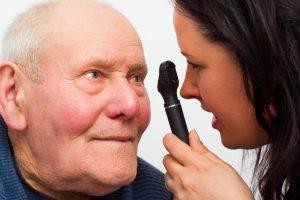Health Habits to Lower Glaucoma Risk

Although no strategies exist to lower glaucoma risk; Healthy habits offer starting point
Although there are no proven strategies to prevent glaucoma, it is a subject worth discussing—particularly with the current renaissance that glaucoma is experiencing.
Louis R. Pasquale, MD, FARVO, professor of ophthalmology, Harvard Medical School, Boston, discussed environmental risk factors for glaucoma and pointed out there are no proven strategies to prevent the disease. He also offered some strategy suggestions.
“If we had a proven strategy to prevent glaucoma, even it worked by 10%, it would be an incredible saving to society in terms of cost and reduced visual disabilities,” Dr. Pasquale said.
Surprisingly, there are some randomized controlled trials that focus on glaucoma prevention, including studies of anthocyanins, antioxidants, and ginkgo biloba. A study of anthocyanins in particular showed a favorable effect, but Dr. Pasquale pointed out that all of these were small studies.
Six suggestions
Dr. Pasquale emphasized that there is not any particular proven strategy to prevent glaucoma, but he shared six suggestions that show promise:
- Eat many green, leafy vegetables. “These are a great source of nitrates that can be converted into nitric oxide,” Dr. Pasquale said. “In primary open-angle glaucoma, there is impaired nitric oxide signaling.” There are drugs in development that will target this highly druggable pathway, he added.
- Protect the eyes from the sun starting at an early age. “There is considerable evidence that sunlight reflected off water and snow may be associated with an increased risk of exfoliation syndrome,” Dr. Pasquale said. “A good strategy to start in your younger years is to protect your eyes from the sun.”
- Maintain good dental health. This strategy may sound odd initially, but there is a theory that periodontal disease could trigger neuroinflammatory markers that reside in the base of the tooth and travel via the blood to the optic nerve. “At least two studies show that those with poor dental health had a greater open-angle glaucoma risk,” he said.
- Exercise in moderation. Moderate exercise is associated with lower intraocular pressure (IOP), but vigorous exercise appears to be associated with primary open-angle glaucoma.
- People should see an ophthalmologist regularly, especially if there is a family history of glaucoma. Pasquale is involved with a NEIGHBORHOOD consortium focused on finding common gene variants for glaucoma. “We hope this effort will translate into people finding out earlier if they are at an increased risk for glaucoma,” Dr. Pasquale said.
- Maintain healthy body weight. Higher body weight and body mass index are associated with metabolic syndrome and diabetes risk. They could also lead to an elevated IOP. However, someone who is thin, has a low body mass index, low blood pressure, and has cold hands and feet could have disturbing autoregulation, leading to an increased risk of normal tension glaucoma.
Two habits to avoid
Dr. Pasquale also shared two habits to avoid to lower one’s risk for glaucoma. First, although a small or moderate amount of coffee consumption is okay, drinking a large amount on a regular basis appears to raise the risk for glaucoma.
Second, inverted head postures as performed in yoga are probably not a good idea. “IOPs measured during these postures have been documented to be quite high,” Dr. Pasquale. “There are plenty of other yoga exercises that people could benefit from that are not associated with a such a marked increase in IOP.”
Sharing these recommendations with patients can be a response to their strong interest in doing something to help control their disease or modify their disease risk, Dr. Pasquale said. However, with all the different forms of glaucoma, the strategies may not work for everyone.
Louis R. Pasquale, MD, FARVO e. louis_pasquale@meei.harvard.edu
This article was published in Ophthalmology Times, adapted from a presentation that Dr. Pasquale delivered during Glaucoma Subspecialty Day held prior to the 2017 American Academy of Ophthalmology meeting. Dr. Pasquale has no financial disclosures relevant to his presentation.
More Resources
As part of New England Low Vision and Blindness’ on-going work to increase awareness about glaucoma and glaucoma-related vision loss and living with glaucoma, we have written a 4-part Guide to Glaucoma. Please share this Guide with friends and remember to get your eyes tested for glaucoma annually. If you do have glaucoma-related vision loss, call us at 888-211-6933 to learn how low vision aids can help you.
In Part One of our series “A Guide to Glaucoma” we discuss what glaucoma is, the warning signs and symptoms of glaucoma, and the stages of glaucoma-related vision loss.
In Part Two of our Glaucoma Guide we discuss who’s at risk for developing glaucoma and how to prevent vision loss from this disease.
In Part Three of our Glaucoma Guide we discuss tests and treatments for glaucoma.
In Part Four of our Glaucoma Guide we discuss how glaucoma affects your vision and low vision and blindness aids for people with vision loss from glaucoma.



